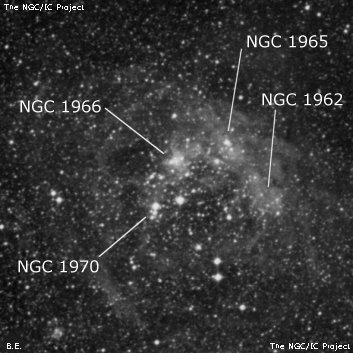
At 200x using a UHC filter, this is a fascinating emission complex as the entire 5' region is awash in bright nebulosity and there are faint, irregular extensions beyond the main portion, particularly to the north (the outer portions form a faint bubble on images). A 10th mag star is involved, though the cluster itself (S-L 476) does not stand out significantly.
NGC 1966 is sometimes applied to the entire complex. Shapley listed the complex as the center of the OB-association "Constellation" II (of V).
John Herschel discovered NGC 1966 = h2868 on 31 Jan 1835 and recorded "the third of a group of four nebulae with stars; pB, R, pslbM. Plate VI, figure 20." Herschel notes this might be Dunlop 77 (two question marks), but this must be an error as the position of D 77 is roughly 04 56 07 -70 07 (2000). Dunlop discovered the entire group (D 136 = S-L 476) and described "a faint confused pretty large nebula. There are a multitude of small nebulae in this place." His position is ~10' too far SW (typical error), though he did not distinguish individual components.
The entire group was also sketched by Joseph Turner on 22 Dec 1875 using the 48" Great Melbourne Telescope (plate III, figure 30 at www.docdb.net/history/texts/1885osngmt________e/lithograph_m_3_30.php).
600/800mm - 24" (4/7/08 - Magellan Observatory, Australia): this number refers to one of the multiple components of a large star cloud and HII complex (LH 58), ~5' in diameter. At 346x this is a small, bright glow on the NE side that surrounds three stars, elongated WNW-ESE, ~40"x15". Fainter nebulosity is attached extending to the west for 1.5' and connecting to the knot NGC 1965. A mag 9.9 star lies 1.2' S. This HII complex is located roughly 12' S of a mag 6.1 star (6.7/7.0 pair at a close 1.4").
Notes by Steve Gottlieb